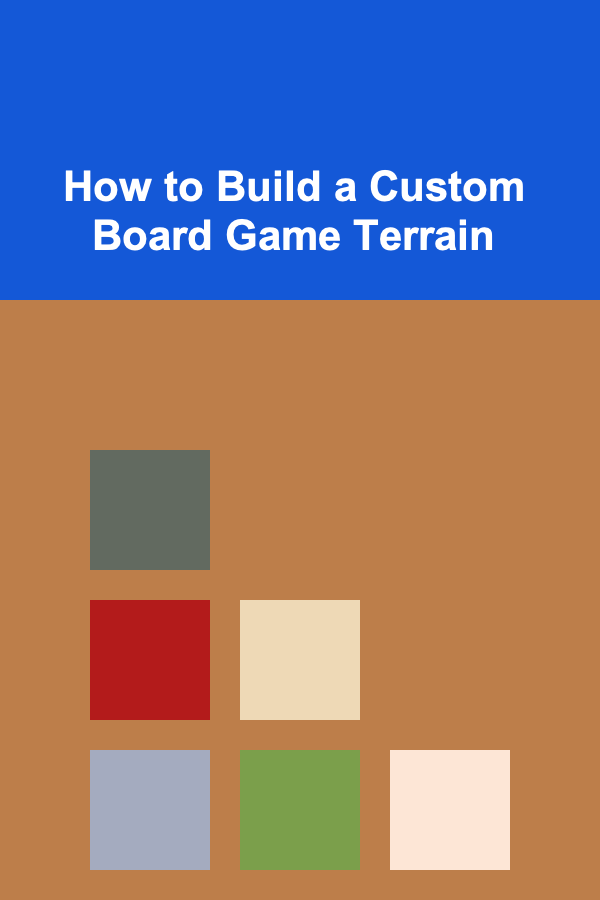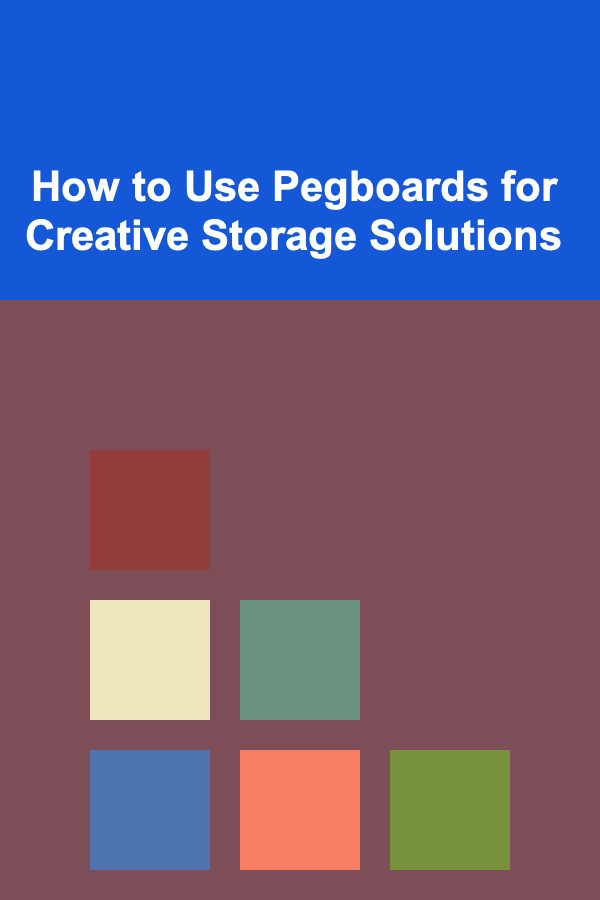
How to Build a Custom Board Game Terrain
ebook include PDF & Audio bundle (Micro Guide)
$12.99$7.99
Limited Time Offer! Order within the next:

Creating custom board game terrain is an exciting and rewarding process for both game designers and enthusiasts. Whether you're designing a terrain for a miniatures game, a tabletop role-playing game (RPG), or a completely original board game, custom terrain can significantly enhance the gameplay experience. It provides a tactile and immersive environment that helps to bring the game's setting and narrative to life. The ability to create and manipulate the terrain gives players a deeper connection to the game world and offers endless possibilities for creativity.
In this article, we'll explore how to build custom board game terrain from scratch, covering essential techniques, materials, and considerations for both beginner and advanced terrain creators. We'll guide you step by step on how to plan, design, and construct your very own custom terrain that fits perfectly with your game's theme and mechanics.
Understanding the Role of Terrain in Board Games
Before diving into the practical steps of building custom terrain, it's important to understand why terrain plays such a vital role in board games.
Immersion and Theme
One of the primary functions of terrain in board games is to immerse players in the game's world. Custom terrain can establish the setting and atmosphere, whether it's a medieval castle, a post-apocalyptic wasteland, or an alien planet. The terrain sets the stage for the story and can make players feel as if they are actually within the world of the game.
Gameplay Mechanics
Terrain can also influence gameplay mechanics. For example, in strategy games involving miniatures, terrain can impact movement, line of sight, and combat. Terrain can act as cover, slow movement, or create obstacles that force players to adapt their strategies. It also helps to divide the board into different zones or areas, adding layers of complexity to the game. Terrain is often designed to support specific rules or mechanics within the game.
Customization
Creating your own custom terrain gives you the freedom to tailor the elements to your exact vision. Whether you want highly detailed and realistic landscapes or abstract, stylized settings, building your own terrain ensures that it perfectly matches the aesthetic and functionality you desire for your game.
Step 1: Plan Your Terrain Design
Before you start gathering materials and building your terrain, it's essential to plan out what you want to create. Good planning is the key to achieving a finished product that enhances the game experience.
Define the Game's Setting
Start by considering the world of your board game. What type of terrain fits the theme of your game? A fantasy game may require forests, mountains, castles, or dungeons, while a science fiction game may involve futuristic cities, alien landscapes, or space stations.
Think about the environment: Is it urban or natural? What is the climate like? Is the terrain flat or hilly? The answers to these questions will guide you in creating terrain that enhances the game's atmosphere.
Determine Gameplay Functionality
Consider the role of the terrain in gameplay. Are there specific features you need, such as elevated areas, water features, or destructible structures? How will the terrain interact with the rules of your game? For example, if you're designing terrain for a miniatures game, think about how the terrain will affect movement, sight lines, or combat. If the terrain is purely decorative for an RPG, you can focus more on aesthetics.
Sketch Your Design
Once you have a solid understanding of the type of terrain you need, sketch your ideas. Rough sketches help visualize the size, layout, and key features of your terrain. Consider how the pieces will fit together on the board and how they will work with the existing game components.
Step 2: Gather Materials
The materials you choose for building your custom terrain will depend on your design, budget, and desired level of detail. The good news is that you don't need to spend a lot of money to create high-quality terrain. Many hobbyists repurpose household items or inexpensive materials to create stunning results.
Common Materials for Terrain Building
- Foam (Polystyrene or XPS): Foam is one of the most versatile materials for building terrain. It's easy to cut, shape, and carve, and it can be painted and textured to create realistic landscapes. Foam sheets can be used to create hills, buildings, and more.
- Cardboard: Simple and affordable, cardboard is often used as a base for terrain. It can be layered or shaped to form buildings, roads, and other structures.
- Plaster or Modelling Putty: These materials are great for creating realistic textures like rocks, cliffs, or uneven ground. They can be sculpted into intricate details.
- Plasticard (Plastic Sheets): Plasticard is ideal for building detailed structures, such as walls, windows, and doors. It's perfect for sci-fi or modern terrain.
- Resin or Epoxy: Used for water features or other special effects like puddles, pools, or rivers.
- Natural Materials: For a more organic feel, natural elements like sand, gravel, moss, twigs, and stones can be used to create realistic terrain textures.
Tools You'll Need
- Craft Knife or Hot Wire Cutter: These tools are essential for cutting foam and shaping it into your desired forms.
- Hot Glue Gun: A hot glue gun is useful for assembling pieces together, especially when using foam or cardboard.
- Paint Brushes: Brushes of various sizes are necessary for painting and adding details to your terrain.
- Sandpaper or File: These tools are used to smooth out rough edges and details on foam or plaster.
- Texture Materials: These include sand, gravel, flock, and other decorative elements that help to give your terrain its final look.
Step 3: Build the Base
The base of your terrain is the foundation that everything will be built upon. The base must be sturdy enough to hold the weight of the terrain and allow for easy movement on the game board.
Choose the Base Shape and Size
Start by cutting a base from cardboard or foam board that matches the size of the area where the terrain will be placed. If your game uses a grid-based board, make sure the base aligns with the grid. The base should be slightly larger than the terrain itself to ensure stability.
Secure the Terrain Features
If you're building structures or larger terrain features, attach them to the base using hot glue or other strong adhesives. For instance, if you're building a hill, glue layers of foam or plaster to the base, building up the height in stages.
For buildings, cut out walls and attach them together using glue. Ensure that your structures are well-aligned and solidly attached to the base.
Step 4: Shape and Sculpt the Terrain
With the base in place, it's time to focus on shaping and sculpting the terrain. This step is where your creative vision truly comes to life.
Carve and Shape Foam
For natural terrain features like hills, cliffs, or mountains, use a craft knife or hot wire cutter to carve foam into your desired shapes. Start with rough cuts and then refine the details as you go. Foam is lightweight and easy to shape, making it perfect for creating landscapes.
Sculpt with Plaster or Putty
For more detailed textures such as rocky surfaces, use plaster or modelling putty. Apply a thin layer to the foam and sculpt it with your hands or tools to create natural-looking features. Let the plaster dry before adding additional layers or textures.
Add Details
Once the major shapes are complete, add smaller details such as cracks, texture, or finer features like tree roots or rubble. Use a combination of carving tools and sandpaper to smooth out or add texture.
Step 5: Paint and Texture the Terrain
Painting and texturing are where your terrain pieces truly shine. The goal is to make the terrain look as realistic and immersive as possible, so take your time in this step.
Paint Base Layers
Start by applying a base coat to your terrain. Use spray paint or acrylic paint to cover the entire surface with a base color, such as earth tones for natural terrain or gray for stone features. This layer should provide a solid foundation for the more detailed painting steps to come.
Dry Brush Highlights
After the base coat has dried, use dry brushing to add highlights and texture. Dry brushing involves lightly dipping a brush in paint and then wiping most of it off. Gently brush the surface to add highlights to raised areas, giving depth to your terrain.
Add Textures
Apply flock, sand, or other texture materials to the terrain. For grass, use static grass flock, and for rocky textures, sprinkle sand or gravel on the surface. You can also add moss or small plants for a more organic look.
Water Effects (Optional)
For water features, such as rivers, lakes, or ponds, use resin or epoxy to create a glossy, realistic water effect. Pour the resin carefully into the desired areas, following the manufacturer's instructions. You can also add effects like ripples or waves with paint.
Step 6: Final Touches
The final step involves adding any last details and ensuring that your terrain is functional for gameplay.
Secure Loose Details
Make sure that any loose details, such as trees, rocks, or debris, are securely attached to the terrain. Use strong glue to ensure they stay in place during gameplay.
Check for Stability
Ensure that the terrain is stable and won't easily tip over or slide around. If necessary, add additional weight or adhesive to the base to ensure stability.
Test the Terrain with Gameplay
Finally, test the terrain with your game. Ensure that it fits properly on the game board and that it functions as expected in terms of gameplay. If necessary, make adjustments to improve the flow and interaction of the game.
Conclusion
Building custom board game terrain is a rewarding project that can enhance the gameplay experience and bring your game's world to life. By carefully planning your design, gathering materials, and following step-by-step instructions, you can create terrain that is both functional and visually stunning. Whether you're a beginner or a seasoned pro, the process of creating custom terrain is an opportunity to get creative and make your game truly unique. Happy building!
Reading More From Our Other Websites
- [Tie-Dyeing Tip 101] Love in Colors: Step‑By‑Step Guide to Tie‑Dyeing the Perfect Heart
- [Home Security 101] How to Detect and Prevent Home Security System Hacking
- [Star Gazing Tip 101] Choosing the Perfect Spot: How to Find Ideal Stargazing Locations
- [Home Lighting 101] How to Light Your Entryway for a Welcoming First Impression
- [Home Storage Solution 101] How to Organize Digital Files and Documents
- [Home Soundproofing 101] How to Reduce Plumbing Noise with Soundproofing Techniques
- [Personal Care Tips 101] How to Pick the Best Soap for After-Sun Care
- [Screen Printing Tip 101] Essential Tools & Materials: Building Your Perfect Screen Printing Kit
- [Organization Tip 101] How to Use Labels for Quick Identification of Equipment
- [Personal Care Tips 101] How to Choose a Face Mask for Post-Sun Care

Can You Make Money with Deep Learning? Here's What You Need to Know
Read More
How to Use Pegboards for Creative Storage Solutions
Read More
The Ultimate Guide to Minimizing Food Waste and Reducing Your Environmental Impact
Read MoreHow to Choose the Best Water Tracker Planner for Your Personality
Read More
10 Tips for Effective Communication on Construction Sites
Read More
How to Scrapbook Family Recipes and Culinary Memories
Read MoreOther Products

Can You Make Money with Deep Learning? Here's What You Need to Know
Read More
How to Use Pegboards for Creative Storage Solutions
Read More
The Ultimate Guide to Minimizing Food Waste and Reducing Your Environmental Impact
Read MoreHow to Choose the Best Water Tracker Planner for Your Personality
Read More
10 Tips for Effective Communication on Construction Sites
Read More